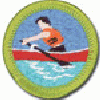
ROWING
These were the REQUIREMENTS before the REVISIONS
made when a new pamphlet was issued during 2006
To see the current requirements
Click Here
To see the changes which were made in 1999,
Click here.
- Show that you know first aid for injuries or illnesses that
could occur while rowing, including hypothermia, heatstroke,
heat exhaustion, dehydration, sunburn, contusions, lacerations,
and blisters.
- Do the following:
- Identify the conditions that must exist before performing
CPR on a person. Explain how such conditions are recognized.
- Demonstrate proper technique for performing CPR using
a training device approved by your counselor.
- Before doing the following requirements, successfully complete
the BSA swimmer test. Jump feetfirst into water over your head
in depth, swim 75 yards in a strong manner using one or more
of the following strokes: sidestroke, breaststroke, trudgen,
or crawl; then swim 25 yards using an easy, resting backstroke.
The 100 yards must be swum continuously and must include at
least one sharp turn. After completing the swim, rest by floating.
- Review and discuss Safety Afloat and demonstrate the proper
fit and use of personal flotation devices (PFDs).
- Alone or with a passenger, do the following correctly in
either a fixed-seat or sliding-seat rowboat:
- Launch and land from and to shore.
- Row in a straight line for a quarter mile. Stop, make
a pivot turn, and return to the starting point.
- Backwater in a straight line for 50 yards. Make a turn
under way and return to the starting point.
- Properly moor or rack your craft. Demonstrate your ability
to tie the following mooring knots: clove hitch, roundturn
with two half hitches, bowline, and hitching tie or mooring
hitch.
- Do ONE of the following:
- In a fixed-seat rowboat, come alongside a dock and help
a passenger into the boat. Pull away from the dock, change
positions with your passenger, and scull in good form over
the stern for 10 yards, including at least one 180-degree
turn. Resume your rowing position, return alongside the
pier, and help your passenger out of the boat.
- In a sliding-seat rowboat, come alongside a pier and,
with your buddy assisting you, get out onto the pier. Help
your buddy into the boat. Reverse roles with your buddy
and repeat the procedure.
- Alone, or with one other person who is a swimmer, tip over
a rowboat.* Turn it right side up, get in, and row or paddle
10 yards with hands or oars. Tell why you should stay with a
swamped boat.
- Alone in a rowboat, push off from the shore or a dock. Row
10 yards to a swimmer. While giving instructions to the swimmer,
turn the boat so that the swimmer can hold onto the stern. Tow
him to shore.
- Show or explain the proper use of anchors for rowboats.
- Describe the following:
- Types of crafts used in commercial, competitive, and
recreational rowing.
- Four common boat building materials. Give some good
and bad points of each.
- Types of oarlocks used in commercial, competitive, and
recreational rowing.
- Discuss the following:
- The advantage of feathering oars while rowing
- How to handle a rowboat in a storm
- How to properly fit out and maintain a boat in season,
and how to prepare and store a boat for winter
- How to calculate the weight a boat may carry under normal
conditions
- The differences between fixed-seat and sliding-seat
rowing
- The different meanings of the term sculling
in fixed- and sliding-seat rowing
- The health benefits from rowing for exercise
* This requirement can be met in shallow water.
BSA Advancement ID#: 98
Pamphlet Revision Date: 1998
Requirements last revised in 1999
|
